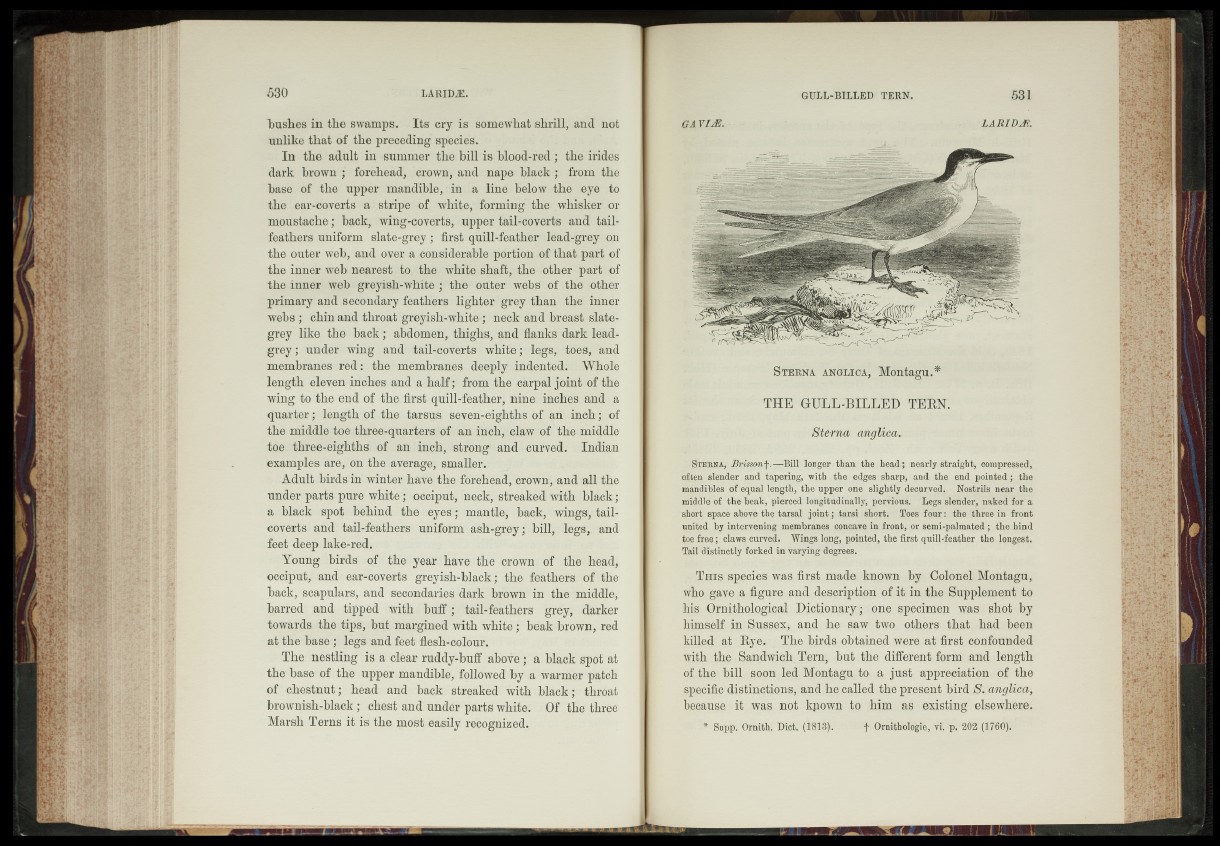
bushes in the swamps. Its cry is somewhat shrill, and not
unlike that of the preceding species.
In the adult in-summer the bill is blood-red ; the irides
dark brown ; forehead, crown, and nape black ; from the
base of the upper mandible, in a line below the eye to
the ear-coverts a stripe r iff white, forming" the whisker or
moustache; back, wing-coverts, upper tail-coverts and tail-
feathers uniform slate-grey; first quill-feather lead-grey on
the outer web, and over, a considerable .portion of that part of
the inner web nearest to. the white shaft, the- 'other part of
the inner web greyish-white ; the outer webs’ of.the other
primary and secondary feathers lighter grey than the' inner
webs ; chin and throat greyish-white'; " neck and .breast slate-
grey like the back; abdomen,, thighs, and flanks dark lead-
grey; under wing and-tail-coverts white;-‘legs; toes,J and
membranes red: the membranes deeply indented^1! Whole
length eleven inches and a:half ';; from the carpal joint, of the
wing to the e’nd of the first quill-feather, ninerdBcbescand a
quarter; length of the tarsus seven-eighths of an inch; |§
the middle toe three-quarters of an inch, claw of the middle
toejj three-eighths of an inch, strong and curved. Indian
■examples are, on the average-, smeller.., .
. Adult birds in winter-have? the forehead, crown, and all the
under parts pure white; occiput, heck-, streaked wlfhnbMc'k ;
a black spot behind the- eyes;; mantle, back, wings, tail-
coverts and tail-feathers- uniform ash-grey; bill, degs^and
feet deep,lake-red.
■ Young ' birds, of the- year havertEe -crown', of fhe- head,
occiput/ and ear-coverts greyish-biackpbl||.feathers1 ofltfe
-lack, scapulars, and secondaries dark brown in the^middle,
barred and tipped with buff; tail-feathers -grey/ darker
towards the tips, but.margined with white; beak brown-, red
at the -base ;‘ legs and feet flesh-colour.
The nestling is a clear ruddy-buff above-* a black spot at
the baserof the upper mandible, followed by: a warmer patch
of chestnut;,-? head- and back streaked, with black ; ? throat
brownish-black; chest and. under parts whiter ~= Of the: three
Marsh Terns ilis the most easily recognized.
GA VIjE. • . . L A R ID M
S t e r n a anglica, Montagu.*
THE GULL-BILLED TERK
Sterna anglicmvs
Sterna, Brisson-\ -jj-BjJI longer than the head; nearly straight, compressed;
often slender and tapering, with. the edges sharp, and, the. end pointed the
mandibles of equal lêngfh, the upper one slightly dee.urved, Nostrils near the
nnddie of thebeaE, pierced lorigitudmlfy, pervious. Legs-sleh'd'eiy naked for a
short space above the tarsal joint; tarsi short,' Toes four: the three in front
ijnited by intervening membranes concave in front, or semi-palmated; the hind
tóe freeclaws curved* Wings long, pointed, the first quill-feather the longest,
Tail' distinctly' forked in varying-degrees.
--.This §pf,cies, wap, first made kuown by Colonel Montagu,
v?hq gave .a figure and description of if in the Supplement to
his Ornithological JDi^tipEisry.; one specimen was shot by
kjmself in Sussex, and he saw two others that had been
killed at Rye. The birds-.obtained were a.t first confounded,
with the San dvfich. Torn, but the different form and length-
pf-the-, bill soon led Montagu, to ,a just appreciation- of the
v^pi%"^stincti°ns, amdrb^.-called. the present bird S. angliecfy,
because it was not kpown to him,, as existing elsewhere,
-- * Supp.-Ornith' Diet. (T8#É)'J f Ornithologie, vi.-p. 202 (l’7öO).